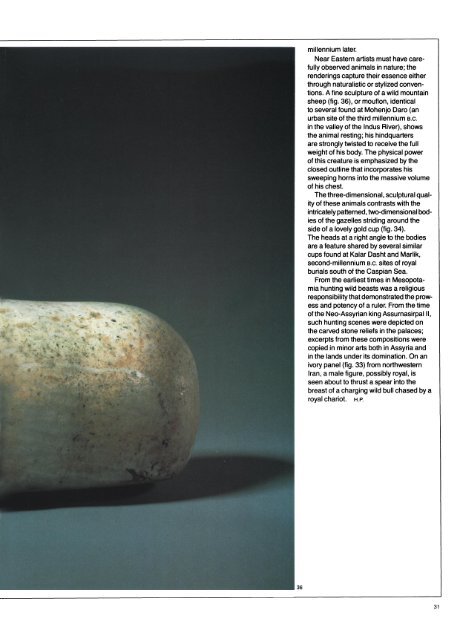Ancient Near Eastern Art: The Metropolitan Museum of Art Bulletin, v ...
Ancient Near Eastern Art: The Metropolitan Museum of Art Bulletin, v ...
Ancient Near Eastern Art: The Metropolitan Museum of Art Bulletin, v ...
You also want an ePaper? Increase the reach of your titles
YUMPU automatically turns print PDFs into web optimized ePapers that Google loves.
millennium later.<br />
<strong>Near</strong> <strong>Eastern</strong> artists must have carefully<br />
observed animals in nature; the<br />
renderings capture their essence either<br />
through naturalistic or stylized conventions.<br />
A fine sculpture <strong>of</strong> a wild mountain<br />
sheep (fig. 36), or mouflon, identical<br />
to several found at Mohenjo Daro (an<br />
urban site <strong>of</strong> the third millennium B.C.<br />
in the valley <strong>of</strong> the Indus River), shows<br />
the animal resting; his hindquarters<br />
are strongly twisted to receive the full<br />
weight <strong>of</strong> his body. <strong>The</strong> physical power<br />
<strong>of</strong> this creature is emphasized by the<br />
closed outline that incorporates his<br />
sweeping horns into the massive volume<br />
<strong>of</strong> his chest.<br />
<strong>The</strong> three-dimensional, sculptural quality<br />
<strong>of</strong> these animals contrasts with the<br />
intricately patterned, two-dimensional bodies<br />
<strong>of</strong> the gazelles striding around the<br />
side <strong>of</strong> a lovely gold cup (fig. 34).<br />
<strong>The</strong> heads at a right angle to the bodies<br />
are a feature shared by several similar<br />
cups found at Kalar Dasht and Marlik,<br />
second-millennium B.C. sites <strong>of</strong> royal<br />
burials south <strong>of</strong> the Caspian Sea.<br />
From the earliest times in Mesopotamia<br />
hunting wild beasts was a religious<br />
responsibility that demonstrated the prowess<br />
and potency <strong>of</strong> a ruler. From the time<br />
<strong>of</strong> the Neo-Assyrian king Assurnasirpal II,<br />
such hunting scenes were depicted on<br />
the carved stone reliefs in the palaces;<br />
excerpts from these compositions were<br />
copied in minor arts both in Assyria and<br />
in the lands under its domination. On an<br />
ivory panel (fig. 33) from northwestern<br />
Iran, a male figure, possibly royal, is<br />
seen about to thrust a spear into the<br />
breast <strong>of</strong> a charging wild bull chased by a<br />
royal chariot. H.P.<br />
36<br />
31

















